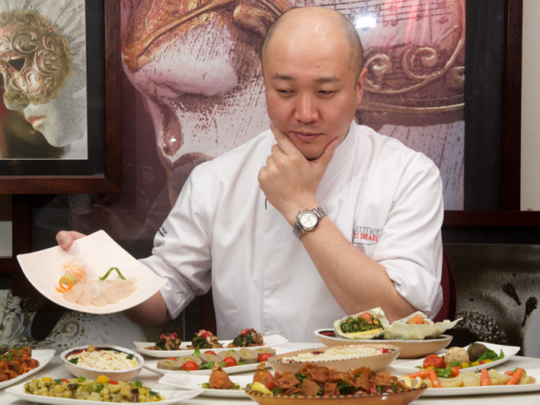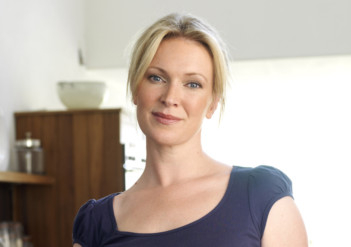
Chef Shinichiro Takagi is held in such high esteem in Japanese culinary circles that he has twice been winged out to New York to rustle up his finest oriental salvers for the Japanese Ambassador to the United Nations.
“I was so nervous the first time [in 2008] I took more than six suitcases just for tableware. I closed my restaurant [in Japan] for a week. I cooked my best sashimi dishes and presented them on my favourite ko sometsuke (porcelain) dishes, which are more than 350 years old. The ambassador loved the food, so it was a proud day,” Takagi recounted with a humble smile when I met him in Abu Dhabi last month.
Chef Takagi was in the UAE experimenting with some local flavours and meze platters to come up with some unique Japanese-meets-Arabian fusion dishes for Gourmet Abu Dhabi, the emirate’s annual culinary festival, which runs over 16 days from February 5 next year.
“I’m still not sure what I’m going to do for my classes [at Gourmet Abu Dhabi], but the wonderful flavours and colours of Arabian cuisine offer so much to my kaiseki style that I’ve got a list of more than 20 ideas already,” he says.
Historic origins
The sashimi dish Takagi served up for ambassador Yukio Takasu comes from the chef’s favoured kaiseki repertoire. Kaiseki is a seasonal, multi-course traditional menu that emanated from 16th-century Japanese tea ceremonies.
The Way of Tea rite classically involves the ceremonial preparation and presentation of matcha — powdered green tea. “But sometimes green tea is too strong for the stomach; that’s why the host of the tea ceremony prepares small dishes of food before we drink the green tea.” These amuse-bouche-like, largely fish-centric courses (an example is pictured right) form the origins of kaiseki, Takagi explains.
The historic and refined concept is today considered the pinnacle of Japanese gastronomic culture. And the multiple, mini portions of a kaiseki menu aren’t going to leave you unbuckling your belt at the dinner table to make room for your bursting belly.
With New Year celebrations around the corner, chef Takagi explains how some kaiseki dishes make for a perfect inclusion in the Osechi-ryori (New Year’s menu): some of which, he says, he is considering cooking at Gourmet Abu Dhabi.
“We make bento boxes (jubako) for New Year’s party menus,” he says. The bento boxes, which are made up of many little individual recipes including fish cakes or kamaboko, boiled seaweed (kombu) and sweetened black soy beans (kuromame), are a similar concept to kaiseki. “Not all the dishes are kaiseki, but we use a lot of the same techniques.
“Red and white are important colours for the New Year’s menu, because [they are] the colours of our national flag, so it’s good luck for the people. One of my favourite dishes for this is the radish and salmon egg.”
Takagi shows me a photo on his BlackBerry of the salmon egg dish that he regularly prepares. It’s an alternating red-and-white-layered piece at the centre of a ten-piece jubako and offers a vibrant immediacy to the eye.
But for sheer gastronomic delight, Takagi’s favourite dishes to cook and eat are gomame (dried niboshi — small sardines), kazunoko (herring eggs) and awabi abalone (sea snails). These rare delicacies take time and experience, he says.
“Gomame is the most difficult.” After desalting the sardines overnight, “you have to cook them with duck soy and sugar in a hot pan, but only for ten seconds,” the Japanese chef says, imitating the action of tossing the sardines in a flammable wok. Such a short burst of actual cooking keeps the fish “very fresh, but you can’t miss the timing — it takes a lot of concentration and experience to prepare,” he says.
The awabi abalone has to be boiled for up to 50 hours on a low flame, explains Takagi, unfazed by what seems to the lay-kaiseki chef an exorbitantly long time. “Two days isn’t that long to prepare a New Year’s dish. The yellow one,” he says, pointing out the kazunoko, “can take five days to cook!”
“You need two days to take the salt out and peel the skin off by hand before leaving it in a marinade for another two days — then you cook it.”
New Year traditions
Considering the amount of time and care that goes into creating the perfect Osechi-ryori-kaiseki menu, it’s no wonder the Japanese aren’t cooking from scratch as much as they used to. But the Asian islanders still place great emphasis on the New Year’s culinary tradition, Takagi says.
“Now less people prepare [the Osechi-ryori] by hand. They will buy ready-made dishes from the supermarket or eat it from my restaurant,” he says.
“Japanese people used to prepare it for themselves because housewives used to be able to stay [at home] and prepare the food. But now many Japanese women go out to work, so there’s no time to spend four days preparing a dish. But Japanese people still consider these traditions to be very important: a part of their heritage,” he says.
Quizzed on whether he will be bringing his famed Japanese flavours to the UAE’s palates, chef Takagi says he’d love to, one day. “[Abu Dhabi and Dubai] are very exciting cities to have a restaurant business.
“I think sushi is very easy for everyone to understand, cook and eat. But I would like to show the UAE Japanese cuisine without sushi: to make people understand that sushi is not the only food from Japan.”
Having discovered that preparation of the local Arabic coffee involves the use of cardamom — to provide health and digestive benefits similar to those of drinking green tea — chef Takagi has added another item to his to-do list when he returns to the capital in less than three-months’ time. “This is something I am very interested in learning more about, and I would relish the opportunity to master the skill of Arabic coffee making when I return,” he says.








